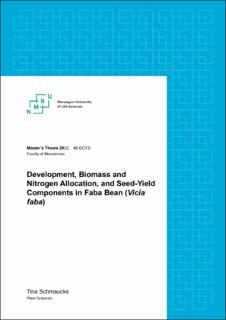| dc.description.abstract | Europe has a great demand in plant-protein for food and feed. A high amount of the demand is met by soy import from South America. Europe and Norway aim to become self-sufficient producers in plant-proteins. One of these plant-proteins is faba bean (Vicia faba). Faba bean is rich in proteins (~30 %) and has several environmental benefits by being added to the cropping system: By fixing atmospheric N symbiotically, it can contribute to the reduction of synthetic nitrogen fertilizer, and by being used as a break crop in cereal production, it can reduce the risk of diseases, and improve soil structure and fertility. However, the production increase of faba bean in Norway has been slow. Several reasons have been mentioned, such as the yield instability, the right selection of varieties, and the lack of information about the crops development and yield requirements under Norwegian conditions. This thesis has the aim to contribute information on how different faba bean varieties performed in their development and yield production in Norway in the growing season 2021. The thesis focuses on four topics concerning faba beans: Firstly, phenology, which observes the influence of temperature on the varieties and how temperature affects the yield, as well as observing differences between early and late varieties. Regarding the registration of the development, the two scales BBCH and GRDC are tested and compared. The second topic has its focus on biomass and looks at the question how and where biomass is allocated and how much is accumulated. Nitrogen is at the centre of the third topic, and answers the questions in which plant organs N is mostly allocated and accumulated and how it changes during plant development. The last topic focuses on the seed-yield components, and looks at which extent the variety has an effect on the yield-components and how the previous topics influence the yield. To research these topics two types of experiments, one greenhouse and one field experiment, were conducted at the Norwegian University of Life Sciences (NMBU) in Ås. In the greenhouse experiment the effect of temperature was tested on the varieties Lielplatones, Vertigo and Sampo. The results showed that at higher temperatures, varieties required more thermal time for emergence until pod maturity. Vertigo was seemingly the most affected by temperature. It was also seen that higher temperature resulted in less yield (lower number of seeds and pods). The field experiment revealed phenological difference between early (Sampo, Vire, and Louhi) and late (Birgit, Daisy, and Vertigo) varieties. The early varieties needed to sum up less thermal time to reach flowering than the late varieties, and they also reached maturity early by requiring less thermal time. Vertigo started flowering earlier than the other two late varieties but matured at the same time as them. By using the BBCH development scale a more detailed variation between varieties was seen, whereas the GRDC scale gave an overview of earliness. Chlorophyll content, biomass-, and nitrogen accumulation was higher in the late varieties. Over 80 % of N in the varieties derived from the symbiosis with rhizobium bacteria. There were only minimal differences in protein content between varieties, yet it was observed that Sampo had the highest protein content with around 34 %. A seed-yield component analysis showed that thousand seed weight (TSW) and biomass correlated strongly with the seed dry weight (DW). The late varieties had the highest seed yield and of all varieties Vertigo had the highest yield. Sowing density seems to play a significant role in determining biomass and seed yield and needs to be investigated further. The results contribute to new knowledge about physiological aspects related to plant development and yield formation in faba bean when grown under Norwegian climate. | en_US |

